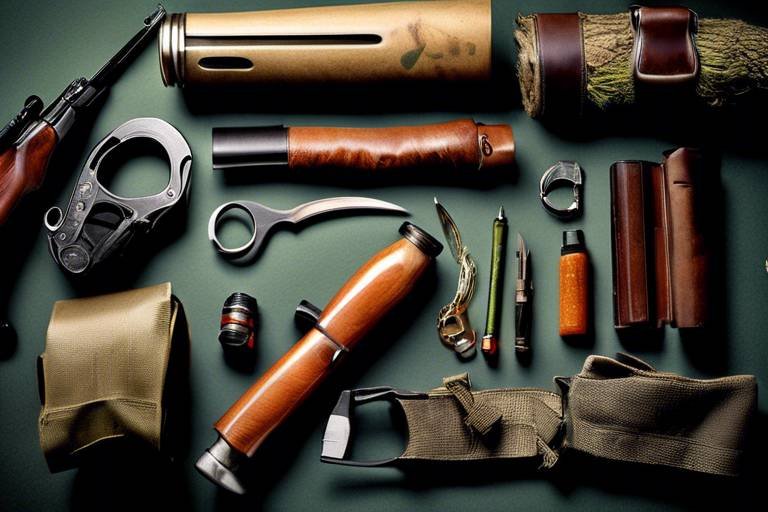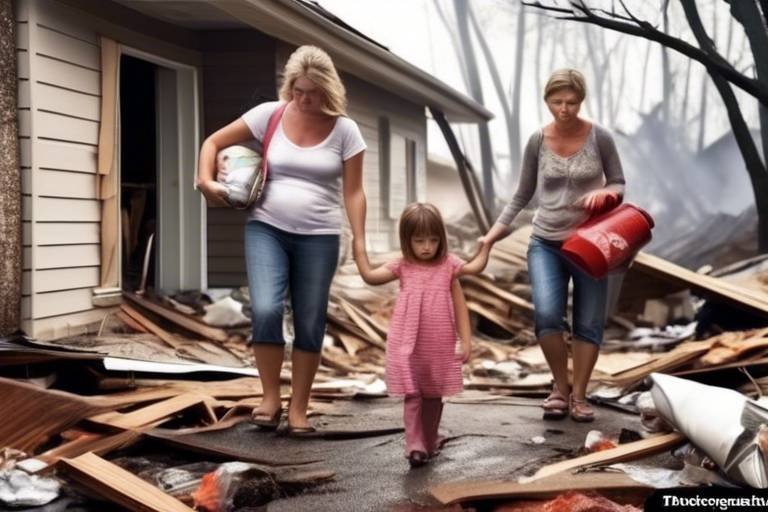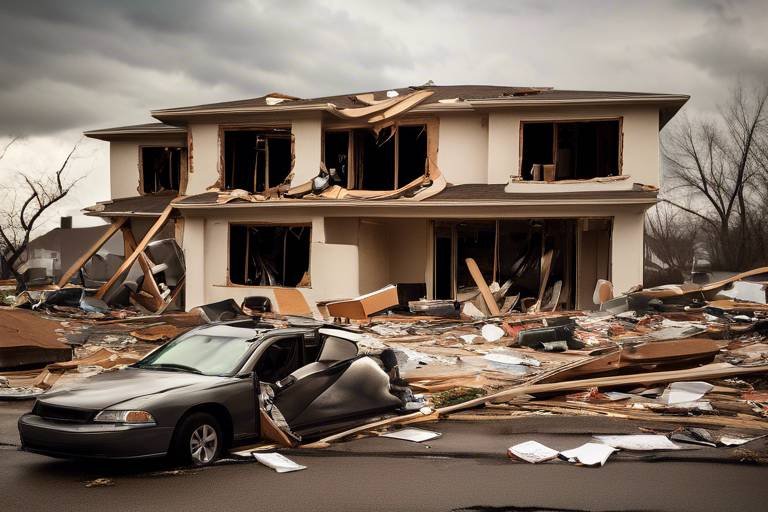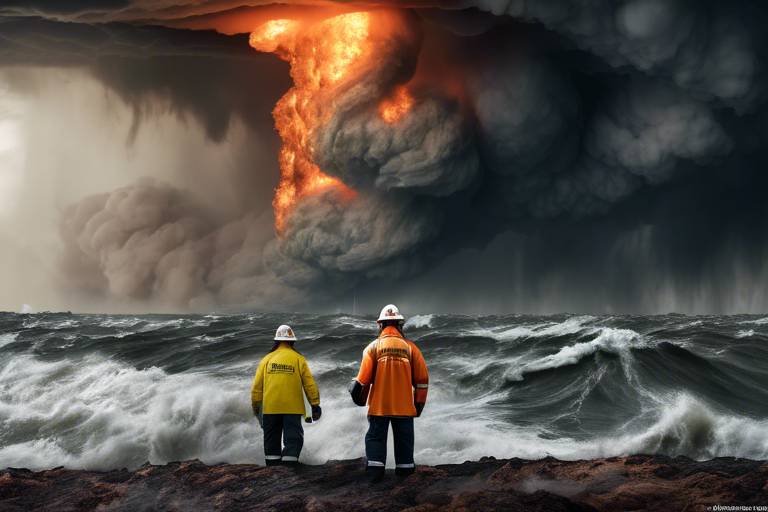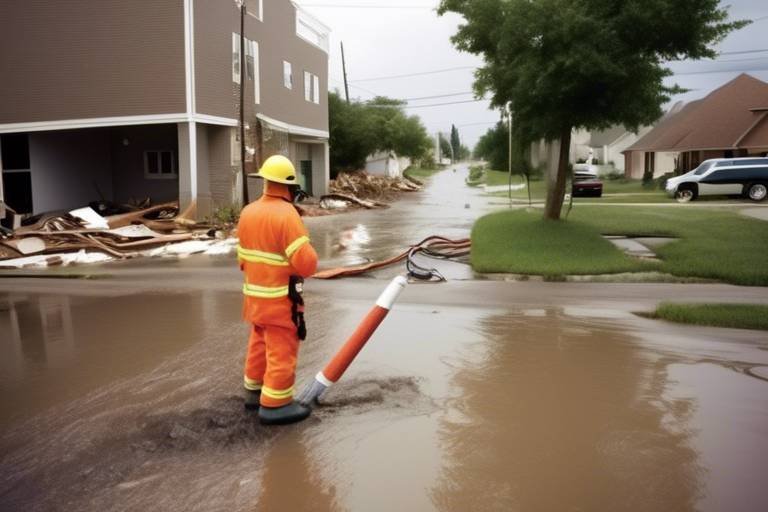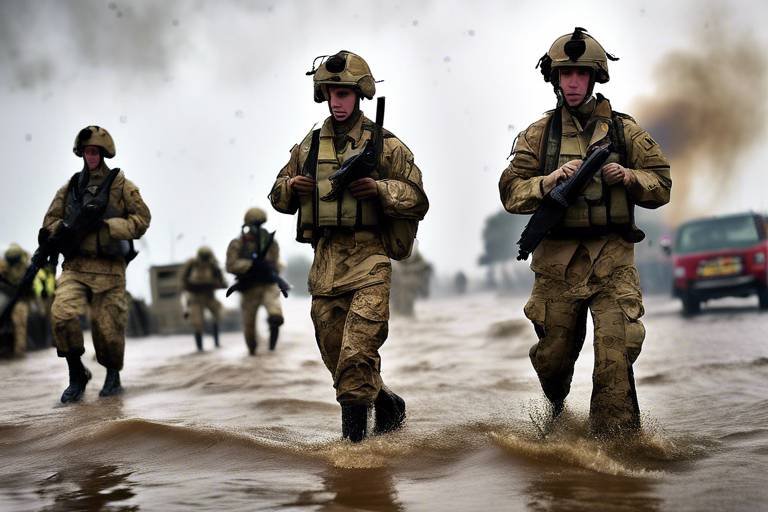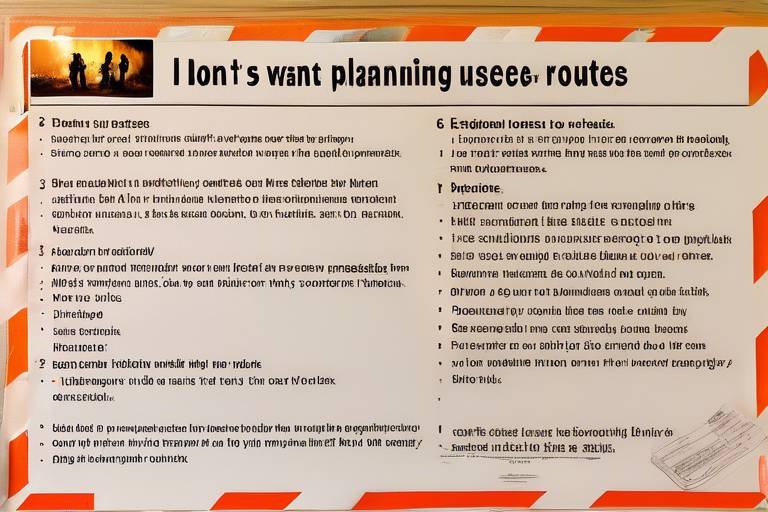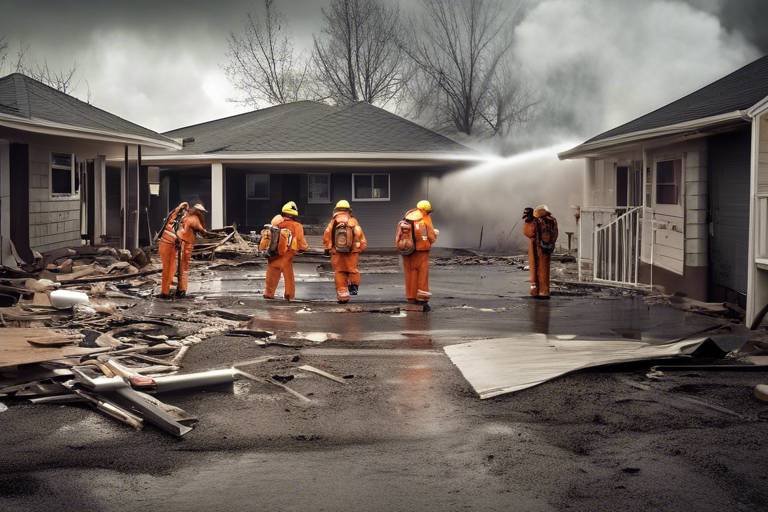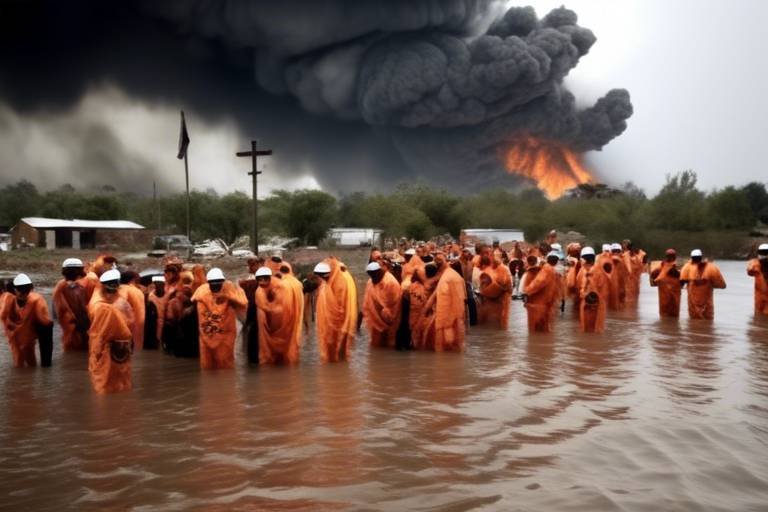Preparing Hunting Equipment for Survival Emergencies
When you think about heading out into the wild, whether it's for a weekend hunting trip or an extended adventure, the last thing on your mind is often survival. But let's face it: the wilderness can be unpredictable. Emergencies can strike at any moment, and being prepared can mean the difference between life and death. So, how do you ensure that you're fully equipped for the unexpected? By understanding the essential hunting gear and preparation strategies, you can significantly enhance your survival chances. This article dives deep into the must-have items that every hunter should carry, emergency survival kits, and practical skills that can keep you safe when the going gets tough.
Understanding the fundamental equipment needed for hunting can significantly improve survival odds. Imagine you're out in the woods, and suddenly, a storm rolls in or you lose your way. Having the right gear can turn a dire situation into a manageable one. So, what are the must-have items every hunter should carry? Here’s a quick rundown:
- Rugged Backpack: A durable backpack is crucial for carrying your gear and supplies. Look for one with multiple compartments for organization.
- Multi-tool: A versatile multi-tool can handle various tasks, from repairing gear to preparing food.
- First Aid Kit: A well-stocked first aid kit is essential for treating injuries.
- Water Filtration System: Access to clean water can be a lifesaver. A portable filtration system should be a priority.
- Fire Starter: Whether it's matches, a lighter, or a fire starter kit, being able to make fire is crucial for warmth and cooking.
These items are just the beginning. The idea is to think ahead and prepare for various scenarios you might face in the wild.
Creating a comprehensive emergency survival kit is crucial for any outdoor adventure. This kit should be tailored to your specific needs and the environment you'll be in. It’s like having a safety net; you hope you never need it, but it’s a relief to know it’s there. Key components should include:
- Non-perishable food items.
- Water purification tablets.
- Emergency blankets or sleeping bags.
- Signaling devices, such as whistles or mirrors.
- Maps and a compass for navigation.
By having these components in your survival kit, you can address various survival scenarios effectively, ensuring you have the essentials covered.
First aid supplies are vital in any survival situation. You might think, “I’m just going hunting; I won’t get hurt.” But accidents happen, and being prepared can make all the difference. Your first aid kit should include items like adhesive bandages, antiseptic wipes, gauze pads, and pain relievers. Each of these items plays a critical role in treating injuries, from minor cuts to more serious wounds.
Knowing basic first aid techniques can save lives. Imagine you've cut yourself while preparing food or encountered a sprained ankle during a hike. Understanding how to clean a wound, apply a bandage, or even perform CPR can be invaluable. Consider taking a first aid course before your trip; it’s a small investment that could pay off big time in an emergency.
Recognizing when to seek professional medical assistance is critical. There are times when self-treatment just isn’t enough. Look for signs such as severe bleeding, broken bones, or symptoms of shock. If you encounter these situations, don’t hesitate to call for help. Remember, your health is paramount.
Navigational tools are essential for staying oriented in the wilderness. It’s easy to get lost, especially in dense forests or unfamiliar terrain. A reliable compass and a detailed map of the area can guide you back to safety. In addition, consider carrying a GPS device or a smartphone with offline maps. Just remember, technology can fail, so having a backup plan is always wise.
Ensuring adequate food and water supplies is crucial for survival. You can't survive long without food and water, so planning is key. Carry non-perishable food items such as energy bars, nuts, and dried fruits. For water, always have a means to purify it, as drinking untreated water can lead to serious health issues.
Foraging for edible plants can supplement food supplies. Imagine walking through the woods and spotting wild berries or edible mushrooms. However, it’s essential to know what’s safe to eat. Research local flora before your trip, and consider carrying a guidebook to help identify edible plants. This knowledge can be a game-changer in a survival situation.
Access to clean water is vital for survival. There are several methods for purifying water, including boiling, using purification tablets, or employing a portable water filter. Each method has its pros and cons, so be sure to choose one that suits your situation. Remember, staying hydrated is crucial, especially when you're exerting yourself in the wilderness.
Q: What should I pack for a day hunting trip?
A: Essentials include water, snacks, first aid kit, multi-tool, and navigation tools.
Q: How do I know if a plant is edible?
A: Always consult a reliable guidebook or app before consuming wild plants.
Q: When should I seek professional help in an emergency?
A: Seek help for severe injuries, persistent pain, or if you feel unwell.

Essential Hunting Gear
This article discusses essential hunting gear and preparation strategies that can enhance survival chances during emergencies, ensuring hunters are well-equipped for unforeseen circumstances in the wild.
When it comes to hunting, having the right gear isn't just about making the hunt successful; it's about ensuring your survival in unpredictable situations. Imagine you're out in the wild, and suddenly, the weather turns, or you find yourself lost. The right equipment can mean the difference between life and death. So, what should you pack to be prepared for these survival emergencies?
First and foremost, a reliable hunting rifle or bow is essential. This is your primary tool for hunting, but it also serves as a means of protection against wildlife threats. Alongside your weapon, carrying a sufficient supply of ammunition is crucial. Always have at least a few extra rounds, as you never know when you might need them.
Next up is a survival knife. This versatile tool can help with everything from preparing food to building shelter. A good knife can also be a lifesaver in emergencies, whether you need to cut rope, skin game, or defend yourself. Choosing a knife with a sturdy blade and a comfortable grip is key.
In addition to these tools, a durable backpack is vital for carrying all your gear. Look for one that is lightweight yet spacious enough to accommodate your essentials. A well-organized backpack can help you quickly access your gear when time is of the essence. Consider opting for a backpack with multiple compartments to keep your items sorted.
Now, let’s talk about clothing. Dressing appropriately for the environment is essential. Layering is the name of the game; it allows you to adjust your warmth as conditions change. Materials like wool and synthetic fabrics are excellent choices because they wick moisture away from your body while keeping you warm. Don’t forget a good pair of waterproof boots to keep your feet dry and comfortable during long treks.
A first aid kit is another non-negotiable item. Accidents can happen, and being prepared with medical supplies can save lives. Your kit should include bandages, antiseptic wipes, pain relievers, and any personal medications you might need. Regularly check and restock your kit to ensure everything is up-to-date.
Finally, consider carrying a fire-starting kit. Whether it's waterproof matches, a lighter, or a flint striker, having a reliable way to start a fire can provide warmth, cook food, and signal for help. Fire is one of the most crucial elements in survival situations, and being able to create one can make all the difference.
To summarize, here’s a quick overview of essential hunting gear:
| Item | Purpose |
|---|---|
| Hunting Rifle/Bow | Primary hunting tool and protection |
| Survival Knife | Versatile tool for various tasks |
| Durable Backpack | Carry and organize gear |
| Appropriate Clothing | Maintain body temperature and comfort |
| First Aid Kit | Treat injuries and ailments |
| Fire-Starting Kit | Create warmth and signal for help |
By equipping yourself with these essential items, you can significantly improve your chances of survival during emergencies while hunting. Remember, preparation is key, and having the right gear can turn a potential disaster into a manageable situation.
Creating a comprehensive emergency survival kit is crucial for any outdoor adventure. This section covers key components that should be included to address various survival scenarios.
First aid supplies are vital in any survival situation. This subsection details necessary medical items to pack and how they can be used in emergencies.
Knowing basic first aid techniques can save lives. This part provides essential skills every hunter should learn to handle injuries effectively.
Recognizing when to seek professional medical assistance is critical. This section discusses indicators that warrant calling for help during emergencies.
Navigational tools are essential for staying oriented in the wilderness. This subsection highlights important devices and methods to ensure hunters can find their way back.
Ensuring adequate food and water supplies is crucial for survival. This section explores strategies for sourcing and purifying water, as well as food storage tips.
Foraging for edible plants can supplement food supplies. This part provides insights into safe foraging practices and identifying nutritious options in the wild.
Access to clean water is vital for survival. This subsection discusses various methods for purifying water to ensure safety during emergencies.
Here are some common questions hunters have regarding essential hunting gear:
- What is the most important piece of gear for survival? While all gear is important, a reliable knife is often considered essential due to its versatility.
- How can I make my first aid kit more comprehensive? Regularly review and update your kit, adding items based on your specific needs and the environment.
- What should I do if I get lost? Stay calm, assess your surroundings, and use your navigation tools to try and find your way back.

Emergency Survival Kits
When you're out in the wild, the unexpected can happen at any moment. That's why having a well-thought-out emergency survival kit is not just a good idea—it's essential. Imagine you're deep in the forest, and suddenly the weather changes, or you get lost. Your survival kit can be your lifeline. So, what should you include in this crucial kit? Let's break it down.
First off, your emergency survival kit should be compact yet comprehensive. Think of it as your little treasure chest of survival tools. You want to pack items that are multi-functional and lightweight, allowing you to carry them easily without weighing you down. A good rule of thumb is to aim for a kit that weighs no more than 10% of your body weight. This ensures you can carry it without getting fatigued, especially during long treks.
Here are some key components that you should definitely consider including:
- Water purification tablets: Clean water is non-negotiable for survival. These tablets can make even the murkiest water safe to drink.
- Non-perishable food items: Think energy bars, nuts, or dehydrated meals. These foods are lightweight and can provide you with the necessary calories during emergencies.
- First aid supplies: Band-aids, antiseptic wipes, and pain relievers are crucial for treating minor injuries.
- Fire-starting tools: A reliable lighter or waterproof matches can be a game-changer for warmth and cooking.
- Multi-tool or knife: These are incredibly versatile and can be used for everything from food preparation to building shelter.
Now, you might be wondering how to organize all these items. A good strategy is to use a sturdy backpack or a dedicated survival bag with multiple compartments. This way, you can easily access what you need without rummaging through everything. Remember, in a survival situation, time is of the essence!
Additionally, it’s wise to periodically check your kit. Items can expire, and you may need to replace them. Make it a habit to review your kit at least twice a year, ensuring everything is in working order and still relevant to your needs.
In summary, an emergency survival kit is not just a collection of items; it’s your safety net in the unpredictable wilderness. By being prepared, you significantly increase your chances of surviving unexpected situations. So, take the time to put together a kit that reflects your personal needs and the environments you plan to explore.

First Aid Supplies
When embarking on a hunting trip, packing the right can make all the difference in an emergency. Imagine you're out in the wilderness, and an unexpected injury occurs. Having a well-stocked first aid kit can mean the difference between a minor inconvenience and a life-threatening situation. So, what should you include in your first aid kit to ensure you're prepared for any scenario?
At a minimum, your first aid kit should contain the following essential items:
- Adhesive Bandages: These are crucial for treating small cuts and scrapes. Make sure to have various sizes to accommodate different injuries.
- Antiseptic Wipes: These help clean wounds to prevent infection, which is vital in outdoor settings.
- Gauze Pads and Tape: For larger wounds, having gauze pads and medical tape is essential for dressing and securing the injury.
- Antibiotic Ointment: This can be applied to cuts and scrapes to further prevent infection.
- Pain Relievers: Over-the-counter medications like ibuprofen or acetaminophen can help manage pain and reduce inflammation.
- Emergency Blanket: A compact emergency blanket can help retain body heat in case of shock or exposure.
- Instant Cold Packs: These are useful for reducing swelling and numbing pain from injuries.
Additionally, it's wise to include any personal medications you might need, such as epinephrine auto-injectors for severe allergic reactions. Don't forget to consider the environment you'll be in; if you're in an area known for ticks, a tick removal tool can be a lifesaver.
Knowing how to use these supplies is just as critical as having them. Familiarize yourself with basic first aid techniques, such as how to clean and dress a wound properly or how to perform CPR. Understanding these skills can empower you to act swiftly and effectively in a crisis.
Furthermore, it's important to regularly check your first aid kit to ensure that supplies are not expired and that everything is in good condition. A first aid kit is not a one-time purchase; it requires maintenance and replenishment just like any other gear you carry.
Ultimately, being prepared with the right first aid supplies not only enhances your safety but also boosts your confidence as you venture into the great outdoors. Remember, the wilderness can be unpredictable, but with the right tools and knowledge, you can navigate through emergencies with greater ease.

Basic First Aid Techniques
When you're out in the wild, knowing some can make all the difference. Imagine you're on a hunting trip, and suddenly, someone trips and falls, injuring their ankle. What do you do? Panic won't help, but having a few first aid skills up your sleeve will. Let’s dive into some essential techniques that every hunter should know, ensuring that you can respond effectively in emergencies.
First and foremost, assessing the situation is crucial. Before rushing in to help, take a moment to evaluate the scene. Is it safe? Are there any hazards? Once you determine that it’s safe, approach the injured person calmly. This will help you both. Remember, your demeanor can influence their reaction. If you look panicked, they might panic too!
One of the most fundamental techniques is the R.I.C.E. method for treating sprains or strains:
- Rest: Encourage the injured person to rest the affected area.
- Icing: Apply ice wrapped in a cloth to reduce swelling.
- Compression: Use a bandage to wrap the injury firmly, but not too tight.
- Elevation: Keep the injured area elevated above heart level to minimize swelling.
Now, let’s talk about cuts and scrapes. It’s common to encounter these when navigating through the wilderness. The first step is to clean the wound with clean water. If you have antiseptic wipes in your first aid kit, use them to disinfect the area. After cleaning, cover the wound with a sterile bandage to prevent infection. Remember, keeping the wound clean is key to promoting healing.
For more serious injuries, such as fractures, immobilization is vital. Use a makeshift splint—this could be anything from a sturdy stick to a rolled-up magazine. The goal is to keep the injured area stable until professional help can be reached. Be gentle when applying the splint, as moving the injured area too much can cause further damage.
Lastly, knowing how to perform CPR (Cardiopulmonary Resuscitation) is invaluable. If someone is unresponsive and not breathing, you may need to step in. Start with chest compressions: place your hands over the center of their chest and push down hard and fast—aim for about 100-120 compressions per minute. If you’re trained, you can also give rescue breaths. Remember, every second counts, and your actions could save a life.
In conclusion, being prepared with basic first aid techniques can significantly enhance your ability to handle emergencies while hunting. It's not just about having the right gear; it's about knowing how to use it effectively. So, take the time to learn these skills, and you’ll be ready to tackle any situation that comes your way in the great outdoors.

When to Seek Professional Help
In the wild, the line between a minor injury and a serious medical emergency can often blur, leaving hunters in a precarious situation. Recognizing when to seek professional help is crucial, as it can mean the difference between a successful recovery and a dire outcome. So, how do you know when it’s time to call for backup? Here are some key indicators to consider:
- Severe Bleeding: If you or someone in your group is experiencing heavy bleeding that doesn’t stop with direct pressure, it’s essential to seek professional medical assistance immediately. This could indicate a serious injury that requires advanced care.
- Loss of Consciousness: If someone becomes unresponsive or loses consciousness, it’s a clear sign that medical help is needed. This could be due to a head injury, shock, or other serious conditions.
- Chest Pain: Chest pain can be a symptom of a heart attack or other critical conditions. If someone complains of this, don’t hesitate to call for help.
- Signs of Infection: If a wound becomes increasingly red, swollen, or produces pus, it may be infected. Infections can escalate quickly in the wilderness, so seeking help is advisable.
- Fractures or Dislocations: If you suspect a broken bone or dislocated joint, it’s important to get professional help. Attempting to self-treat these injuries can lead to further complications.
In addition to these specific signs, it’s also vital to trust your instincts. If something doesn’t feel right, or if the injured person is showing unusual symptoms, don’t hesitate to call for help. It’s better to err on the side of caution. Remember, when you’re in the wilderness, time can be of the essence. Having a reliable means of communication, such as a satellite phone or a two-way radio, can make all the difference in getting timely assistance.
Moreover, it’s essential to have a plan in place before you embark on your hunting adventure. Inform someone about your itinerary and expected return time, so they can raise the alarm if you don’t come back as scheduled. A little preparation can go a long way in ensuring that help is available when you need it most.
Ultimately, being aware of your surroundings and understanding the limits of your first aid skills will empower you to make informed decisions. In the wilderness, your ability to recognize when to seek professional help can be a lifesaver, ensuring that you and your companions stay safe during your outdoor pursuits.
- What should I do if I can't reach professional help? If help is unreachable, focus on stabilizing the injured person and provide first aid as best as you can. Use your survival kit to manage their condition until you can get them to safety.
- How can I prepare for emergencies before going hunting? Always carry a well-stocked first aid kit, have a communication device, and inform someone about your plans. Learning basic first aid skills is also beneficial.
- What are some signs that indicate a serious injury? Look for signs such as severe bleeding, unconsciousness, chest pain, or any symptoms that seem out of the ordinary for the injured person.

Navigation Tools
When you find yourself deep in the wilderness, the last thing you want is to feel lost and disoriented. are your best friends in such situations, providing you with the means to find your way back home safely. Think of these tools as your compass to stability in the unpredictable wilderness. Whether you're an experienced hunter or a weekend warrior, understanding how to use these tools effectively can make all the difference in an emergency.
Firstly, let’s talk about the classic compass. This simple yet powerful tool helps you understand your direction relative to the Earth's magnetic poles. It's like having a personal guide that doesn’t need batteries! To use a compass, you need to first understand the basics of reading it. Align the compass needle with the north on the dial, and you’ll know which way you're headed. But remember, a compass is only as good as your ability to read it. Practice makes perfect!
Next up, we have the GPS device. These handy gadgets can pinpoint your exact location using satellites. While they are incredibly useful, they do rely on battery power, so you must ensure to bring extra batteries or a solar charger along. Imagine having a digital map in your pocket that updates in real-time! However, keep in mind that technology can fail, and it’s always wise to have a backup navigation method—like a compass.
Another indispensable tool is the map. Unlike electronic devices, a physical map doesn’t run out of battery, making it a reliable companion for any outdoor venture. Familiarize yourself with reading topographical maps, which show elevation changes and terrain features. Understanding how to read these maps is akin to deciphering a treasure map; it requires practice but can lead you to safety.
To make navigation even easier, consider carrying a multi-tool. These compact devices often come equipped with a knife, screwdriver, and other essentials, which can be invaluable in survival situations. You can use them to mark your path on a map or even carve out directional markers in the trees. It's like having a Swiss army knife of navigation at your fingertips!
Lastly, don’t underestimate the power of natural navigation. Learning how to use the sun, stars, and even the position of trees can be incredibly useful. For instance, in the Northern Hemisphere, the sun rises in the east and sets in the west. By observing these natural cues, you can orient yourself even without any tools. It’s like tapping into the ancient wisdom of nature!
In summary, having the right navigation tools can be a game-changer in survival scenarios. A combination of a compass, GPS device, map, multi-tool, and knowledge of natural navigation will significantly increase your chances of finding your way back. So, before you head out into the wild, make sure you're equipped with these essential navigation aids. After all, it’s better to be safe than sorry!
- What should I do if my GPS fails? If your GPS fails, rely on your compass and map. Familiarize yourself with how to read both before your trip.
- Can I use my smartphone for navigation? Yes, smartphones can be used for navigation, but ensure you have offline maps downloaded and a portable charger.
- How do I practice natural navigation? Spend time outdoors observing the sun’s movement and the position of stars at night to improve your natural navigation skills.

Food and Water Preparation
When it comes to survival, food and water are your top priorities. Imagine being stranded in the wilderness, with your energy dwindling and your thirst intensifying. It’s not just about staying alive; it’s about thriving until help arrives. Understanding how to secure and prepare these essential resources can make all the difference between a harrowing experience and a manageable one. So, let’s dive into some strategies that can help you stay nourished and hydrated during emergencies.
First and foremost, let’s talk about water. Did you know that you can survive without food for weeks, but only a few days without water? This makes it crucial to know how to find and purify water in the wild. Natural sources like rivers, streams, and lakes can be your best friends, but be cautious—these waters can harbor harmful pathogens. Always remember to purify your water before drinking. Methods such as boiling, using water purification tablets, or employing a portable water filter can effectively eliminate bacteria and parasites.
Here’s a quick overview of some popular water purification methods:
| Method | Description | Pros | Cons |
|---|---|---|---|
| Boiling | Heating water to a rolling boil for at least one minute. | Effective against most pathogens. | Requires fuel and time. |
| Water Purification Tablets | Chemical tablets that kill bacteria and viruses. | Portable and easy to use. | May leave an aftertaste. |
| Portable Water Filter | Filters that remove contaminants as you drink. | Convenient and effective. | Can clog with heavy use. |
Next up, let’s not forget about food. Foraging for edible plants can be an exciting and rewarding experience. However, it’s important to have a basic understanding of what’s safe to eat. Some common edible plants include:
- Dandelions - Every part is edible, from the roots to the flowers!
- Wild berries - Blackberries and raspberries are delicious, but be cautious of look-alikes.
- Acorns - These can be leached to remove tannins and ground into flour.
While foraging can supplement your food supply, it’s wise to have non-perishable food items in your emergency kit. Think of items like energy bars, dehydrated meals, and canned goods. These foods are lightweight, easy to store, and can provide the necessary calories to keep you going. Just imagine biting into a chewy energy bar after a long day of trekking—pure bliss when you’re hungry!
In addition to knowing how to find food and water, it’s also crucial to understand how to store and prepare them. For instance, if you’ve caught fish or hunted small game, ensure you have a method to cook it—whether it’s over an open fire or using a portable stove. Food safety is essential; always cook meat thoroughly to avoid any foodborne illnesses.
In conclusion, being prepared with the right knowledge and tools for food and water preparation can significantly enhance your survival chances in the wild. So before heading out, take some time to familiarize yourself with local edible plants, practice purifying water, and pack some reliable food supplies. Your future self will thank you!
Here are some common questions related to food and water preparation during survival situations:
- How much water should I carry? - Ideally, aim for at least two liters per day, but this can vary based on activity level and climate.
- Can I eat wild mushrooms? - It’s best to avoid wild mushrooms unless you are 100% certain they are safe, as many can be toxic.
- What’s the best way to cook food in the wild? - Grilling over an open flame or using a portable stove are both effective methods.

Foraging Techniques
Foraging is an essential skill for any hunter or outdoor enthusiast, especially during survival emergencies. Imagine being lost in the wilderness, your supplies dwindling, and the only way to sustain yourself is by tapping into nature's bounty. Foraging allows you to identify and harvest wild edibles, providing you with the necessary nutrients to survive. However, the key to successful foraging lies in knowledge and practice. It’s not just about picking random plants; it’s about understanding what’s safe to eat and what’s not.
First and foremost, familiarize yourself with the local flora before heading out. This preparation can make a significant difference in your survival experience. Consider carrying a field guide or downloading a foraging app on your smartphone. These resources can help you identify edible plants, berries, and mushrooms. Remember, some plants can be toxic, so it’s crucial to have a reliable source of information.
When foraging, look for plants that are commonly found in your area. Here are a few examples of edible plants you might encounter:
- Dandelions: Every part of this plant is edible, from the roots to the flowers.
- Wild Garlic: A flavorful addition to meals, it can be found in many wooded areas.
- Chickweed: This tender green is excellent in salads and packed with nutrients.
Foraging is not just about gathering food; it’s also about understanding the environment. Pay attention to the ecosystem around you. Look for signs of wildlife, as animals often lead you to nutritious plants. Additionally, consider the seasons; certain plants are only available during specific times of the year. For instance, berries are typically abundant in late summer, while nuts are harvested in the fall. Timing your foraging trips can greatly enhance your chances of finding food.
Another important aspect of foraging is sustainability. Always practice ethical foraging by taking only what you need and leaving enough for wildlife and future foragers. A good rule of thumb is to harvest no more than one-third of a plant to ensure it can continue to thrive. This approach not only helps maintain the ecosystem but also ensures that you can return to the same spot in the future.
Lastly, always be cautious when trying new foods. If you're unsure about a plant, it's best to err on the side of caution. Start by sampling a small amount and wait for any adverse reactions before consuming more. This practice can prevent potential poisoning and ensure your foraging adventures remain safe and enjoyable.
Q: How do I know if a plant is safe to eat?
A: Research local edible plants beforehand and use a reliable field guide or app to confirm their identity. When in doubt, avoid consuming it.
Q: Can I forage in any area?
A: Be mindful of local laws and regulations regarding foraging. Some areas may have restrictions, especially in protected parks and reserves.
Q: What should I do if I feel sick after eating foraged food?
A: Seek medical attention immediately if you experience symptoms of poisoning, such as nausea, vomiting, or dizziness.
Q: Are there any plants I should avoid at all costs?
A: Yes, plants like poison ivy, poison oak, and certain mushrooms can be highly toxic. Familiarize yourself with these before heading out.

Water Purification Methods
Access to clean water is not just a luxury; it’s a necessity for survival in the wild. When you're out hunting or exploring, you may find yourself in situations where fresh water is scarce. Knowing how to purify water can mean the difference between life and death. Let’s dive into some effective methods that can help you ensure that the water you consume is safe.
One of the most common and effective methods of purifying water is boiling. It's simple and doesn’t require any special equipment other than a heat source. By bringing water to a rolling boil for at least one minute (or three minutes at higher altitudes), you can kill most pathogens, including bacteria, viruses, and parasites. This method is so reliable that it’s often referred to as the gold standard in water purification.
Another popular method is the use of water filters. Portable water filters come in various forms, from pump filters to gravity filters, and they can effectively remove contaminants from water. When choosing a filter, look for one that can remove both bacteria and protozoa. Some advanced filters even eliminate viruses, but always check the specifications. A good filter can be a lifesaver, especially if you’re in an area where water sources are questionable.
For those who are more adventurous or resourceful, chemical purification can also be an option. Water purification tablets, which often contain iodine or chlorine dioxide, can be used to disinfect water. Simply add the recommended number of tablets to your water, wait for the specified time, and voila! You have purified water. However, it’s essential to follow the instructions carefully, as improper use can lead to ineffective purification.
If you find yourself without any of the above tools, you might consider using solar disinfection. This method, often referred to as SODIS, involves filling clear plastic bottles with water and leaving them in direct sunlight for six hours or more. The UV rays from the sun can kill harmful bacteria and viruses, making the water safer to drink. This method is particularly useful in sunny climates and requires no special equipment.
Lastly, if you’re in a pinch and have access to natural materials, you can try filtration through sand and charcoal. This method involves layering sand, gravel, and activated charcoal in a container, then pouring water through it. While this won't kill pathogens, it can remove larger particles and improve the water's taste. Remember, this method should be followed by boiling or chemical purification to ensure safety.
In summary, having multiple water purification methods at your disposal can significantly enhance your survival chances in the wilderness. Whether you choose to boil, filter, chemically treat, use solar disinfection, or create a makeshift filter, being prepared is key. Always remember to carry a backup method, as relying on a single technique can leave you vulnerable in an emergency.
- How do I know if the water is safe to drink? Always purify water from natural sources, as it may contain harmful pathogens.
- Can I use a coffee filter to purify water? Coffee filters can remove larger particles but should not be relied upon for purification. Always follow up with boiling or chemical treatment.
- How long do I need to boil water to purify it? Boil water for at least one minute, or three minutes at altitudes above 6,500 feet.
- Is solar disinfection effective in cloudy weather? Solar disinfection is less effective in cloudy weather but can still work if the sun is partially visible.
Frequently Asked Questions
- What essential hunting gear should I carry for emergencies?
When heading out into the wild, it's crucial to have the right gear. Essential items include a reliable knife, a first aid kit, a map and compass, a multi-tool, and a sturdy flashlight. These tools not only aid in hunting but also enhance your survival odds in unexpected situations.
- How do I create a comprehensive emergency survival kit?
A well-prepared emergency survival kit should include items like non-perishable food, water purification tablets, a whistle, a fire starter, and a durable tarp. Think of it as your lifeline in the wilderness; every item serves a purpose, ensuring you're ready for whatever nature throws your way.
- What first aid supplies are essential for hunters?
Your first aid kit should contain adhesive bandages, antiseptic wipes, gauze pads, medical tape, and pain relievers. These supplies can be lifesavers when injuries occur. It's like having a mini hospital in your backpack, ready to tackle minor injuries before they escalate.
- What basic first aid techniques should every hunter know?
Every hunter should be familiar with techniques like controlling bleeding, performing CPR, and treating burns. Think of these skills as your survival toolkit; knowing them can mean the difference between life and death in critical situations.
- When should I seek professional medical help in an emergency?
It's important to recognize when a situation is beyond your control. If you encounter severe injuries, signs of shock, or persistent pain, it's time to call for professional help. Trust your instincts; if something feels off, don’t hesitate to reach out for assistance.
- What navigation tools are recommended for hunters?
To stay oriented in the wilderness, carry a compass, a detailed map of the area, and a GPS device if possible. These tools are your best friends for finding your way back and avoiding getting lost in the wild.
- How can I ensure I have enough food and water during a hunting trip?
Plan ahead by packing enough non-perishable food and a reliable water purification system. Always have a backup plan for sourcing water, like knowing nearby streams or carrying purification tablets. It's all about being prepared and staying hydrated!
- What are some safe foraging techniques for edible plants?
Foraging can be a great way to supplement your food supplies, but it's crucial to know what you're looking for. Stick to well-known edible plants and always double-check with a reliable guide. It's like being a culinary explorer in the wild; just ensure you know what’s safe to eat!
- What water purification methods should I use in the wild?
Common water purification methods include boiling, using water filters, and chemical purification tablets. Each method has its pros and cons, so choose the one that fits your situation best. Clean water is your lifeblood in survival scenarios, so never take chances!

